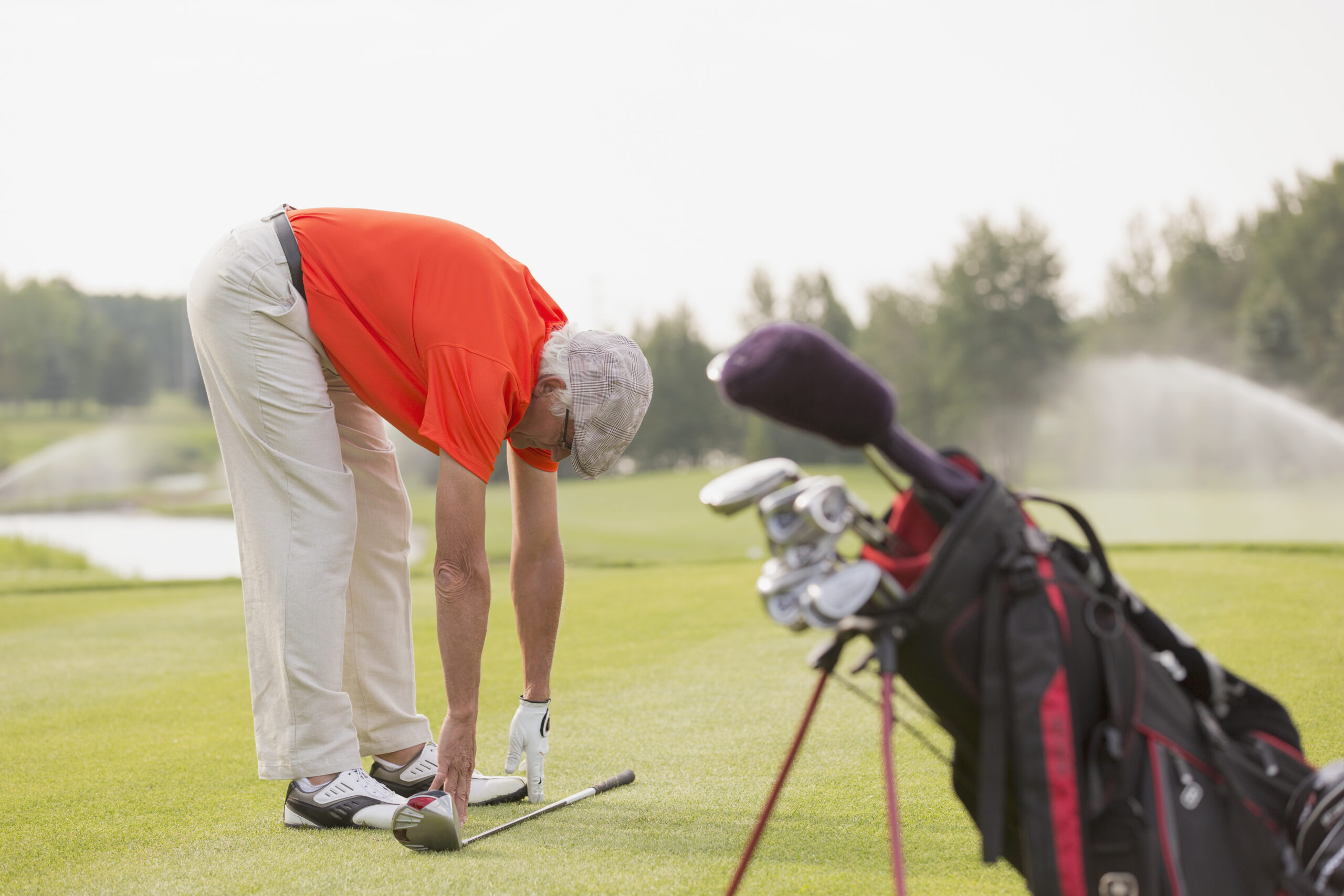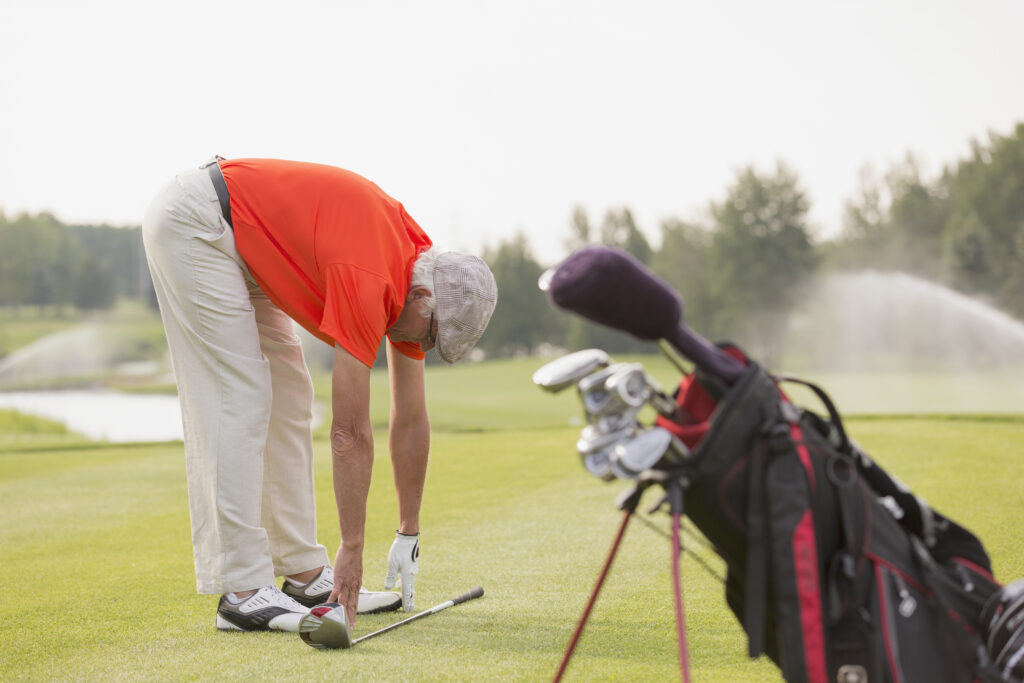Preventing Common Over-Use Golf Injuries

Golf injuries are real. They can linger for a long time and take away from your love for the sport. But there are things you can do to prevent some of these common injuries and pains. With the proper attention and consistency, you can set yourself up for a long, enjoyable relationship with the game of golf. Let’s take a look at some of the more common injury spots and some potential ways to prevent them.

Back Pain
While back pain is a general term, for golfers it’s usually the result of having stiff muscles while trying to swing the golf club too fast with limited rotation ability and lack of proper muscle recruitment. When your muscles are stiff, your range of motion is limited and your body is working against your swing. If you force things to happen, bad results for your swing and your body are usually close behind.
The challenge with swinging a golf club is that it’s a rapid, explosive motion. It doesn’t give your muscles a chance to gradually adapt if they’re not already able to perform that range of motion.
Prevent It: To help prevent back pain while you’re out on the course, it’s critical to warm up by stretching your entire body before tee time. Perform exercises between rounds to strengthen your core, so you are better able to use your hips for turning power instead of your back.
Elbow Injuries
Tendonitis is one of the most common elbow injuries in the world and is caused by inflamed tendons and ligaments in your elbow. When your outer tendon is inflamed, we call it “tennis elbow.” When it’s your inner tendon, it’s “golfer’s elbow.”
As we get older, our risk of getting tendonitis increases, especially if we’ve been performing activities that require repetitive movements. Hitting golf balls is a perfect example.
Prevent It: To help reduce the inflammation, give yourself plenty of time to rest. To prevent these injuries from happening in the first place, work on building the muscles around your elbow (forearms, biceps and triceps) and at the shoulder to help give your arm a strong foundation to work from. Stronger muscles will support your tendons and allow you to enjoy golf for longer periods of time.
Knee Pain
Not many people realize how many muscles, ligaments and tendons are used during a single golf swing. And the legs make up a big part of them. Your knees play an important role in stabilizing your body and rotating the hips at the beginning of your swing. Because of the explosive movement, extreme force is placed on the knee. If that knee is weak, you run the risk of straining or tearing ligaments.
Prevent It: While there are many treatment options, you can help your knees by stretching your hips and calves, as well as maintaining a flexible body. Performing exercises to strengthen your muscles, ligaments and tendons will improve the durability of your knees. Recovery is also important. If your knees are sore after a day of golf, put some ice on them to prevent swelling and inflammation, and take an extra day or two between rounds. However, swelling and inflammation after a round is a good indicator you need more than ice. Mobility and strength training are important to keep those knees viable for the years ahead.
Rotator Cuff Injuries
If you feel a sharp pain in your shoulder or upper arm while swinging your golf club, you might be dealing with the start of a rotator cuff injury. Check with your doctor. Other common symptoms include experiencing pain during the night and when you extend your arm overhead.
Rotator cuff injuries are often the result of traumatic force. For golfers, it can happen when you poorly execute a golf swing, hit a rock or simply overuse your muscles.
Prevent It: Common treatments include anti-inflammatory drugs (talk to your doctor) and sometimes surgery. You can help prevent rotator cuff injuries by improving shoulder flexibility and doing golf-specific weight training exercises to strengthen and properly utilize the rotator cuff musculature.
Wrist Injuries
Swinging a golf club is a repetitive motion. If your body isn’t equipped to handle these repetitive motions, injuries are far more likely to occur.
Your wrists are no exception. The typical high-speed swing places a lot of explosive pressure on your wrists. Pain and tenderness are commonly experienced at the moment of impact and at the top of your backswing.
Prevent It: Many wrist injuries are a form of tendonitis. When sore and inflamed you can use ice or anti-inflammatory to ease the inflammation. Check with your doctor first. Much like the other prevention methods mentioned in this article, the wrists will also benefit from strengthening and mobilizing. As well as rest when they are sore.
Golf requires you to be in good physical condition to truly enjoy and perform well for years to come. You will need mobility exercises to maintain a flexible body with good range of motion, along with strength exercises to protect your joints and improve stability and body control. Add that with proper swing mechanics and you are on your way to some pain free golf. Just like with any training, take your time, start slow and progress as your body adapts.
If you have any questions or other thoughts to share, I would love to hear from you!
Brian@BetterTogetherFitness.com
BetterTogetherFitness.com











Leave a Reply